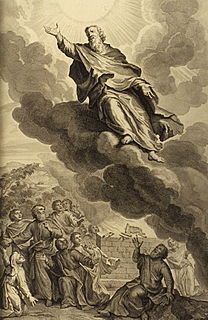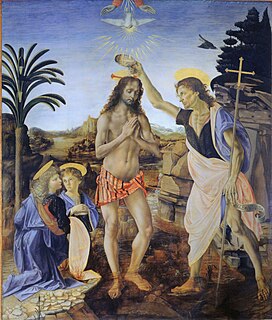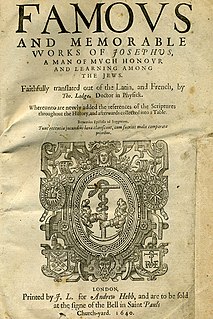Related Research Articles

The Bible is a collection of religious texts or scriptures sacred in Christianity, Judaism, Samaritanism, and many other faiths. It appears in the form of an anthology, a compilation of texts of a variety of forms, originally written in Hebrew, Aramaic, and Koine Greek. These texts include instructions, stories, poetry, and prophesies, among other genres. The collection of materials that are accepted as part of the Bible by a particular religious tradition or community is called a biblical canon. Believers generally consider the Bible to be a product of divine inspiration while understanding what that means in different ways.

The Epistle of Jude, often shortened to Jude, is the penultimate book of the New Testament as well as the Christian Bible. It is traditionally attributed to Jude the Apostle, brother of James the Just, and thus possibly brother of Jesus as well.

The First Epistle to the Corinthians, usually referred to as First Corinthians or 1 Corinthians is a Pauline epistle of the New Testament of the Christian Bible. The epistle is attributed to Paul the Apostle and a co-author named Sosthenes, and is addressed to the Christian church in Corinth. Scholars believe that Sosthenes was the amanuensis who wrote down the text of the letter at Paul's direction. It addresses various issues that had arisen in the Christian community at Corinth and it is composed in a form of Koine Greek.

The extant manuscripts of the book Antiquities of the Jews, written by the first-century Jewish historian Flavius Josephus around 93–94 AD, contain two references to Jesus of Nazareth and one reference to John the Baptist.

The Roman historian and senator Tacitus referred to Jesus, his execution by Pontius Pilate, and the existence of early Christians in Rome in his final work, Annals, book 15, chapter 44.
"Son of man", "son of Adam", or "like a man", are phrases used in the Hebrew Bible, various apocalyptic works of the intertestamental period, and in the Greek New Testament. In the indefinite form used in the Hebrew Bible it is a form of address, or it contrasts human beings against God and the angels, or contrasts foreign nations, which are often represented as animals in apocalyptic writings, with Israel which is represented as human, or it signifies an eschatological human figure.

The Samaritan Pentateuch, also known as the Samaritan Torah, is a text of the Torah, written in the Samaritan script and used as sacred scripture by the Samaritans. It dates back to one of the ancient versions of the Hebrew Bible that existed during the Second Temple period, and constitutes their entire biblical canon.

Enoch is a biblical figure and patriarch prior to Noah's flood and the son of Jared and father of Methuselah. He was of the Antediluvian period in the Hebrew Bible.
The question of the historicity of Jesus is part of the study of the historical Jesus as undertaken in the quest for the historical Jesus and the scholarly reconstructions of the life of Jesus. Virtually all scholars of antiquity accept that Jesus was a historical figure, although interpretations of a number of the events mentioned in the gospels vary and are a subject of debate. Standard historical criteria have aided in evaluating the historicity of the gospel narratives, and only two key events are subject to "almost universal assent", namely that Jesus was baptized by John the Baptist and crucified by order of the Roman Prefect Pontius Pilate.

The Book of Enoch is an ancient Hebrew apocalyptic religious text, ascribed by tradition to Enoch, the great-grandfather of Noah. Enoch contains unique material on the origins of demons and Nephilim, why some angels fell from heaven, an explanation of why the Genesis flood was morally necessary, and prophetic exposition of the thousand-year reign of the Messiah.
The term "historical Jesus" refers to the reconstruction of the life and teachings of Jesus by critical historical methods, in contrast to religious interpretations. It also considers the historical and cultural contexts in which Jesus lived. Virtually all scholars of antiquity accept that Jesus was a historical figure, and attempts to deny his historicity have been consistently rejected by the scholarly consensus as a fringe theory.
The Johannine Comma is an interpolated phrase in verses 5:7–8 of the First Epistle of John.

The baptism of Jesus by John the Baptist is a major event in the life of Jesus which is described in three of the gospels: Matthew, Mark and Luke. It is considered to have taken place at Al-Maghtas, also called Bethany Beyond the Jordan, today located in Jordan.
The criterion of multiple attestation, also called the criterion of independent attestation or the cross-section method, is a tool used by Biblical scholars to help determine whether certain actions or sayings by Jesus in the New Testament are from the Historical Jesus. Simply put, the more independent witnesses that report an event or saying, the better. This criterion was first developed by F. C. Burkitt in 1906, at the end of the first quest for the historical Jesus.

Misquoting Jesus: The Story Behind Who Changed the Bible and Why is a book by Bart D. Ehrman, a New Testament scholar at University of North Carolina at Chapel Hill. The book introduces lay readers to the field of textual criticism of the Bible. Ehrman discusses a number of textual variants that resulted from intentional or accidental manuscript changes during the scriptorium era. The book made it to The New York Times Best Seller List.

The Slavonic Josephus is an Old East Slavic translation of Flavius Josephus' History of the Jewish War which contains numerous interpolations and omissions that set it apart from all other known versions of Josephus' History. The authenticity of the interpolations was a major subject of controversy in the 20th century, but the latest scholarship has rejected them.

Gospel of Matthew 16:2b–3, the passage describes a confrontation between Jesus and the Pharisees and Sadducees over their demand for a sign from heaven. It is one of several passages of the New Testament that are absent from many early manuscripts. The authenticity of the passage has been disputed by scholars since the second half of the 19th century.
The historical reliability of the Gospels is the reliability and historic character of the four New Testament gospels as historical documents. While all four canonical gospels contain some sayings and events which may meet one or more of the five criteria for historical reliability used in biblical studies, the assessment and evaluation of these elements is a matter of ongoing debate. Almost all scholars of antiquity agree that a human Jesus existed, but scholars differ on the historicity of specific episodes described in the biblical accounts of Jesus, and the only two events subject to "almost universal assent" are that Jesus was baptized by John the Baptist and was crucified by the order of the Roman Prefect Pontius Pilate. Elements whose historical authenticity is disputed include the two accounts of the Nativity of Jesus, the miraculous events including the resurrection, and certain details about the crucifixion.

A biblical canon is a set of texts which a particular Jewish or Christian religious community regards as part of the Bible.

Christian sources, such as the New Testament books in the Christian Bible, include detailed stories about Jesus, but scholars differ on the historicity of specific episodes described in the biblical accounts of Jesus. The only two events subject to "almost universal assent" are that Jesus was baptized by John the Baptist and was crucified by the order of the Roman Prefect Pontius Pilate.
References
- ↑ G. Nickelsburg, “Son of Man.“ in Anchor Bible Dictionary 6.138.
- ↑ The Enoch-Metatron Tradition - Page 82 3161485440 Andrei A. Orlov - 2005 "The same interchangeability is observable in the titles “son of man“ and “chosen one.” Here ... 88 Some scholars believe that these chapters might represent later interpolation(s) and do not '83 G. Nickelsburg, “Son of Man.“ ABD 6.138."
- ↑ The Lamb Christology of the Apocalypse of John Page 87 316148164X Loren L. Johns - 2003 " 2.2 Testament of Benjamin 3:8 The same sort of Christian interpolation is evident in Testament of Benjamin 3:8, where, according to Howard Clark Kee, "the major text traditions include a Christian interpolation."53"
- ↑ John the Baptizer and Prophet: A Sociohistorical Study - Page 39 1597529869 Robert L. Webb - 2006 "2.3 The Authenticity of Ant. 18.116-19 The authenticity of Josephus' narrative concerning John the Baptist has often been critically examined. While a few have rejected it as a Christian interpolation, most scholars have accepted it."
- ↑ Louis Feldman ( ISBN 90-04-08554-8 pages 55–57) states that the authenticity of the Josephus passage on James has been "almost universally acknowledged".
- ↑ Josephus: The Essential Writings - Page 265 Paul L. Maier - 1990 "scholars have long suspected a Christian interpolation, since Josephus would not have believed Jesus to be the ..."